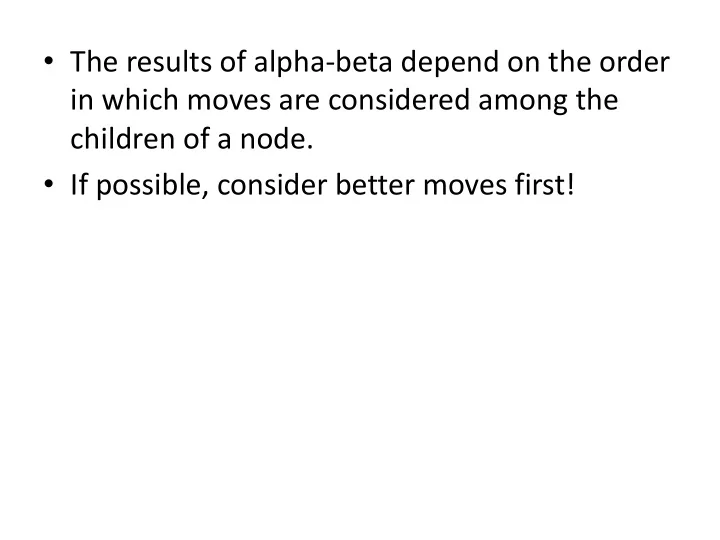

• The results of alpha-beta depend on the order in which moves are considered among the children of a node. • If possible, consider better moves first!
Real-world use of alpha-beta • (Regular) minimax is normally run as a preprocessing step to find the optimal move from every possible situation. • Minimax with alpha-beta can be run as a preprocessing step, but might have to re-run during play if a non-optimal move is chosen. • Save states somewhere so if we re-encounter them, we don't have to recalculate everything.
Real-world use of alpha-beta • States get repeated in the game tree because of transpositions . • When you discover a best move in minimax or alpha-beta, save it in a lookup table (probably a hash table). – Called a transposition table .
Real-world use of alpha-beta • In the real-world, alpha-beta does not "pre- generate" the game tree. – The whole point of alpha-beta is to not have to generate all the nodes. • The DFS part of minimax/alpha-beta is what generates the tree.
Improving on alpha-beta • Alpha-beta still has to search down to terminal nodes sometimes. – (and minimax has to search to terminal nodes all the time!) • Improvement idea: can we get away with only looking a few moves ahead?
Heuristic minimax algorithm h-minimax(s, d) = heuristic-eval(s) if cutoff(s, d) max a in actions(s) h-minimax(result(s, a ), d+1) if player(s)=MAX min a in actions(s) h-minimax(result(s, a ), d+1) if player(s)=MIN result(s, a) means the new state generated by taking action a in state s . cutoff(s, d) is a boolean test that determines whether we should stop the search and evaluate our position.
How to create a good evaluation function? • Trying to judge the probability of winning from a given state. • Typically use features: simple characteristics of the game that correlate well with the probability of winning.
One last point O O O MAX X X X O O O O O O MIN X X X X X X X X utility=1 O O O O O O O MAX X X X O X X X X X etc… O O O O X X X X X utility=1
What if a game has a � chance element � ?
What if a game has a � chance element � ? We know how to value the other nodes. How do we value chance nodes?
Expected value • The sum of the probability of each possible outcome multiplied by its value: ∑ E ( X ) = p i x i i • x i is a possible value of (random variable) X. • p i is the probability of xi happening.
Expected minimax value • Now three different cases to evaluate, rather than just two. – MAX – MIN – CHANCE EXPECTED-MINIMAX-VALUE ( n ) = UTILITY ( n ), If terminal node max s Î successors(n) MINIMAX-VALUE ( s ), If MAX node min s Î successors(n) MINIMAX-VALUE ( s ), If MIN node å s Î successors(n) P(s) • EXPECTEDMINIMAX ( s ), If CHANCE node
Recommend
More recommend